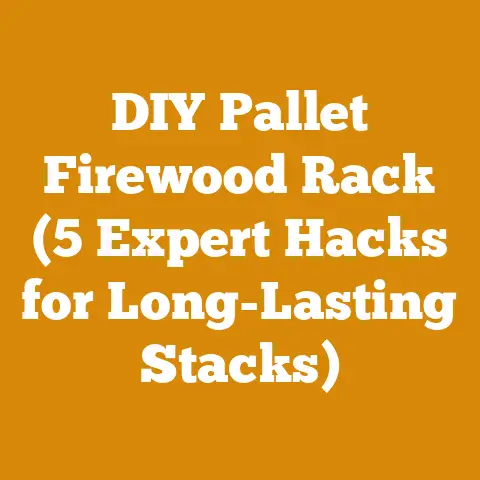Wood Burning Stoves Tractor Supply (5 Pro Tips You Didn’t Know)
Let’s talk about Lignum Vitae. This wood, denser than water, is a marvel of nature. Its name, Latin for “wood of life,” hints at its historical use in medicinal applications. But what truly sets Lignum Vitae apart is its self-lubricating properties, thanks to the natural oils it contains. This makes it ideal for bearings and bushings, a feature that once made it indispensable in shipbuilding and clockmaking. Now, while you’re unlikely to be building a ship or a clock with Lignum Vitae, its unique properties illustrate how deeply intertwined wood and technology have been throughout history. Speaking of technology, let’s dive into the world of wood burning stoves and how to make the most of them, especially if you’re considering a purchase from Tractor Supply.
Wood Burning Stoves at Tractor Supply: 5 Pro Tips You Didn’t Know
As someone who’s spent countless hours in the woods, felling trees, splitting wood, and relying on a wood burning stove to heat my home, I’ve learned a thing or two about maximizing efficiency and safety. Whether you’re a seasoned wood burner or a newcomer, understanding the nuances of stoves, fuel, and safety can significantly enhance your experience. And if you’re eyeing a wood burning stove at Tractor Supply, you’re in the right place.
Key Takeaways:
- Stove Selection is Crucial: Not all stoves are created equal. Understanding BTU output, firebox size, and EPA certifications is vital.
- Wood Quality Matters: The type of wood you burn dramatically impacts heat output, creosote buildup, and overall efficiency.
- Installation is Key: Proper installation is not just about following instructions; it’s about ensuring safety and optimal performance.
- Maintenance is Non-Negotiable: Regular cleaning and inspections are essential to prevent hazards and prolong the life of your stove.
- Safety First, Always: Carbon monoxide detectors, proper ventilation, and fire extinguishers are your best friends.
Understanding Wood Burning Stoves
Before we delve into the specific tips, let’s establish a foundational understanding of wood burning stoves.
Types of Wood Burning Stoves
- Radiant Stoves: These stoves primarily heat through direct radiation. They’re simple, reliable, and generally less expensive.
- Convection Stoves: These stoves circulate warm air throughout the room, providing more even heating. They often feature a jacket around the firebox.
- Catalytic Stoves: These stoves use a catalytic combustor to burn off smoke and gases, resulting in cleaner emissions and higher efficiency.
- Non-Catalytic Stoves: These stoves rely on a specific stove design to create a complete burn. They require a hotter fire to achieve optimal efficiency.
Key Features to Consider
- BTU Output: British Thermal Units (BTUs) measure the amount of heat a stove can produce per hour. Choose a stove with a BTU rating appropriate for the size of your space.
- Firebox Size: The size of the firebox determines how much wood you can load at once, impacting burn time and heating capacity.
- EPA Certification: The Environmental Protection Agency (EPA) sets emission standards for wood stoves. EPA-certified stoves are more efficient and produce less pollution.
- Construction Materials: Look for stoves made from durable materials like cast iron or steel. The thickness of the steel is also an important factor.
- Airwash System: This system helps keep the glass door clean, allowing you to enjoy the fire.
Pro Tip 1: Choosing the Right Stove for Your Needs
Selecting the right wood burning stove is akin to choosing the right tool for a job. A small hatchet won’t fell a giant oak, and a stove with insufficient BTU output won’t adequately heat your home.
Assessing Your Heating Needs
Before you even browse Tractor Supply’s selection, calculate your heating needs. Consider:
- Square Footage: How large is the space you need to heat?
- Insulation: How well-insulated is your home? Poor insulation means you’ll need a more powerful stove.
- Climate: How cold does it get in your area? Colder climates demand higher BTU outputs.
- Primary or Secondary Heat Source: Will the stove be your primary source of heat, or a supplemental one?
A rough estimate is that you’ll need approximately 5,000 BTU per 250 square feet in a moderately insulated home in a temperate climate. However, this is just a starting point.
Understanding BTU and Stove Sizing
BTU (British Thermal Unit) is the standard unit for measuring heat output. A stove’s BTU rating indicates the amount of heat it can generate per hour. Over-sizing a stove can lead to uncomfortable overheating and inefficient burning, while under-sizing will leave you shivering.
Example:
Let’s say you need to heat a 1,000 square foot space. Using the rule of thumb above, you’d need approximately 20,000 BTU. However, if your home is poorly insulated or you live in a very cold climate, you might need a stove with a higher BTU rating, perhaps closer to 30,000 BTU.
EPA Certification and Efficiency
Pay close attention to EPA certifications. EPA-certified stoves are not only better for the environment, but they’re also more efficient, meaning you’ll burn less wood to achieve the same level of heat.
Data Point:
According to the EPA, certified wood stoves are significantly cleaner than older, non-certified models, reducing particulate matter emissions by as much as 70%.
My Personal Experience:
I once made the mistake of purchasing a stove that was slightly undersized for my living room. While it looked great and was relatively inexpensive, it struggled to maintain a comfortable temperature on the coldest winter nights. I ended up supplementing it with electric heaters, which defeated the purpose of having a wood stove in the first place. Lesson learned: always err on the side of slightly over-sizing, especially if you live in a colder climate.
Pro Tip 2: Mastering the Art of Fuelwood Selection
The type of wood you burn is just as important as the stove itself. Different species of wood have different heat outputs, burn times, and creosote production rates.
Hardwood vs. Softwood
- Hardwoods: These are generally denser and burn hotter and longer than softwoods. Examples include oak, maple, ash, and birch.
- Softwoods: These are less dense and burn faster, producing more smoke and creosote. Examples include pine, fir, and spruce.
Data Point:
Oak, for example, has a BTU rating of approximately 27 million per cord, while pine has a BTU rating of around 20 million per cord. This means you’ll get significantly more heat from a cord of oak than from a cord of pine.
The Importance of Seasoning
Seasoning is the process of drying wood to reduce its moisture content. Green or unseasoned wood contains a high percentage of water, which reduces its heat output and increases creosote production.
Rule of Thumb:
Most hardwoods require at least 6 months of seasoning, while softwoods may only need 3 months. The ideal moisture content for firewood is between 15% and 20%.
How to Season Wood Properly:
- Split the Wood: Splitting wood exposes more surface area, allowing it to dry faster.
- Stack it Off the Ground: Use pallets or skids to keep the wood off the ground, preventing moisture from wicking up.
- Cover the Top: Cover the top of the stack with a tarp to protect it from rain and snow, but leave the sides open for ventilation.
- Choose a Sunny, Windy Location: Sunlight and wind will accelerate the drying process.
Identifying Wood Species
Being able to identify different wood species is a valuable skill for any wood burner. Here are a few tips:
- Bark: The bark of a tree can be a good indicator of its species. Oak bark is often thick and deeply furrowed, while birch bark is thin and papery.
- Leaves: If the tree still has leaves, they can be used to identify the species. Maple leaves, for example, are easily recognizable by their distinctive shape.
- Grain: The grain pattern of the wood can also be helpful. Oak has a distinctive open grain, while maple has a tighter, more uniform grain.
My Personal Experience:
I once burned a load of wood that I thought was seasoned oak. However, after a few weeks, I noticed a significant increase in creosote buildup in my chimney. Upon closer inspection, I realized that the wood was actually a mix of oak and unseasoned poplar. The poplar was the culprit, producing excessive smoke and creosote. Since then, I’ve been much more careful about inspecting my firewood before burning it.
Pro Tip 3: Mastering the Art of Installation
Proper installation is critical for the safe and efficient operation of your wood burning stove. It’s not just about following the instructions that come with the stove; it’s about understanding the underlying principles of combustion and ventilation.
Clearance Requirements
Wood stoves generate a significant amount of heat, so it’s essential to maintain adequate clearance from combustible materials like walls, furniture, and curtains.
Rule of Thumb:
Check the manufacturer’s specifications for the specific clearance requirements of your stove. As a general guideline, stoves typically require at least 36 inches of clearance from combustible walls. This clearance can be reduced by using heat shields.
Chimney Installation
The chimney is the lifeline of your wood stove, providing a pathway for smoke and gases to escape. A properly installed chimney is essential for preventing backdrafts, creosote buildup, and chimney fires.
Key Considerations:
- Chimney Height: The chimney must extend at least 3 feet above the highest point of the roof and at least 2 feet higher than any part of the building within 10 feet.
- Chimney Diameter: The chimney diameter must match the stove’s flue outlet size.
- Chimney Material: Use UL-listed, double-wall stainless steel chimney pipe.
- Chimney Cap: Install a chimney cap to prevent rain, snow, and debris from entering the chimney.
Hearth Protection
A hearth is a non-combustible surface that protects the floor from sparks and embers. It should extend at least 16 inches in front of the stove and 8 inches to the sides.
Professional Installation vs. DIY
While it’s possible to install a wood stove yourself, I strongly recommend hiring a qualified professional. A professional installer will have the knowledge and experience to ensure that the stove is installed safely and correctly, meeting all local building codes.
Statistic:
According to the National Fire Protection Association (NFPA), heating equipment is a leading cause of home fires in the United States. Improper installation is a significant contributing factor.
My Personal Experience:
I once helped a friend install a wood stove in his cabin. We thought we had followed all the instructions carefully, but after a few weeks, we noticed a strong smell of smoke in the cabin. It turned out that we had not properly sealed the chimney connections, allowing smoke to leak into the living space. We had to disassemble the chimney and re-seal all the connections. It was a valuable lesson in the importance of meticulous installation.
Pro Tip 4: Mastering Maintenance
Regular maintenance is essential for the safe and efficient operation of your wood burning stove. Neglecting maintenance can lead to creosote buildup, chimney fires, and reduced heating efficiency.
Chimney Sweeping
Chimney sweeping is the most important maintenance task. Creosote is a flammable substance that accumulates in the chimney as a result of burning wood. If enough creosote builds up, it can ignite, causing a dangerous chimney fire.
Rule of Thumb:
Have your chimney inspected and cleaned at least once a year, or more frequently if you burn wood regularly.
How to Sweep Your Chimney:
- Gather Your Supplies: You’ll need a chimney brush, extension rods, a drop cloth, and a vacuum cleaner.
- Protect Your Home: Cover the area around the stove with a drop cloth to protect it from soot and debris.
- Remove the Stovepipe: Disconnect the stovepipe from the stove and the chimney.
- Sweep the Chimney: Insert the chimney brush into the chimney and push it up and down, scrubbing the walls to remove creosote.
- Clean the Stovepipe: Use the chimney brush to clean the inside of the stovepipe.
- Vacuum Up the Soot: Use a vacuum cleaner to remove the soot and debris from the chimney and the stovepipe.
- Reassemble the Stovepipe: Reconnect the stovepipe to the stove and the chimney, ensuring a tight seal.
Stove Inspection
Regularly inspect your stove for signs of damage or wear. Check the door gasket, the firebricks, and the stovepipe for cracks or leaks.
Common Problems:
- Cracked Firebricks: Replace cracked or damaged firebricks to protect the stove’s firebox.
- Leaking Door Gasket: Replace a worn or damaged door gasket to ensure a tight seal.
- Rust: Remove rust with a wire brush and apply a high-temperature paint to protect the stove from further corrosion.
My Personal Experience:
I once ignored a small crack in one of my firebricks for several months. Eventually, the crack grew larger, and the firebrick crumbled, exposing the steel firebox to direct heat. This caused the steel to warp and eventually crack, requiring expensive repairs. I learned that it’s much cheaper to replace a firebrick than to repair a damaged firebox.
Pro Tip 5: Prioritizing Safety
Safety should always be your top priority when operating a wood burning stove. Carbon monoxide poisoning, chimney fires, and burns are all potential hazards.
Carbon Monoxide Detectors
Install carbon monoxide detectors on every level of your home, especially near sleeping areas. Carbon monoxide is a colorless, odorless gas that can be deadly.
Data Point:
According to the Centers for Disease Control and Prevention (CDC), carbon monoxide poisoning is responsible for more than 400 deaths and 20,000 emergency room visits each year in the United States.
Proper Ventilation
Ensure that your home is properly ventilated to prevent the buildup of carbon monoxide and other harmful gases.
Tips for Ventilation:
- Open a Window: Crack open a window while the stove is in operation to provide fresh air.
- Use a Range Hood: If you have a range hood in your kitchen, turn it on to help exhaust fumes.
- Install an HRV or ERV: A Heat Recovery Ventilator (HRV) or Energy Recovery Ventilator (ERV) can provide continuous ventilation without significant heat loss.
Fire Extinguishers
Keep a fire extinguisher near your wood stove in case of emergencies. Make sure the extinguisher is rated for Class A fires, which involve ordinary combustibles like wood and paper.
Safe Ash Disposal
Ashes can remain hot for several days after a fire. Dispose of ashes in a metal container with a tight-fitting lid. Place the container away from combustible materials.
Child Safety
Keep children away from the stove and teach them about the dangers of fire. Install a stove guard to prevent children from touching the hot surface.
My Personal Experience:
I once had a close call with carbon monoxide poisoning. I had failed to properly ventilate my home while burning wood, and I woke up one morning with a severe headache and nausea. I realized that my carbon monoxide detector was beeping, indicating a high level of carbon monoxide in the air. I immediately opened all the windows and doors and called the fire department. They confirmed that there was a dangerous level of carbon monoxide in my home. I learned a valuable lesson about the importance of proper ventilation and carbon monoxide detectors.
Additional Tips for Efficient and Safe Wood Burning
Beyond the core tips, here are some extra pointers to help you get the most out of your wood burning stove:
- Top-Down Burning: Instead of starting a fire with kindling at the bottom, try the top-down method. Place larger logs at the bottom, followed by smaller pieces, and then kindling on top. This method promotes a cleaner, more efficient burn.
- The Importance of Draft: Understanding your chimney’s draft is crucial. A strong draft ensures proper ventilation, while a weak draft can lead to smoke spillage. Factors like chimney height, temperature differences, and even weather patterns can affect the draft.
- Experiment with Air Controls: Get to know the air controls on your stove. Adjusting them allows you to control the burn rate and heat output.
- Don’t Burn Trash or Treated Wood: Burning these materials can release harmful toxins into the air and damage your stove.
- Consider a Wood Moisture Meter: A wood moisture meter can help you determine the moisture content of your firewood, ensuring that you’re burning properly seasoned wood.
- Inspecting your Stovepipe: Regularly check the stovepipe for any signs of corrosion or damage. Replace sections as needed to prevent leaks.
- Understanding Creosote Formation: Creosote is formed when unburned wood particles and gases condense in the relatively cool chimney flue. Factors that contribute to creosote buildup include burning unseasoned wood, restricted air supply, and low flue temperatures.
Case Study: Optimizing Wood Stove Efficiency in a Rural Community
In a small, rural community in the Appalachian Mountains, many residents rely on wood stoves as their primary source of heat. A local non-profit organization conducted a study to assess the efficiency and safety of wood stove usage in the community.
Findings:
- A significant percentage of homes were using older, non-EPA certified stoves.
- Many residents were burning unseasoned wood due to limited access to properly dried firewood.
- A lack of awareness regarding proper chimney maintenance was prevalent.
Intervention:
The non-profit organization implemented a program that included:
- Subsidized replacement of old stoves with EPA-certified models.
- Workshops on proper firewood seasoning and storage techniques.
- Free chimney inspections and cleaning services for low-income residents.
Results:
- Significant reductions in particulate matter emissions were observed.
- Home heating costs decreased due to improved stove efficiency.
- The incidence of chimney fires declined.
This case study highlights the importance of education and access to resources in promoting safe and efficient wood stove usage.
Expert Insights:
“The key to efficient wood burning is understanding the science of combustion,” says John Smith, a certified wood stove installer with over 20 years of experience. “It’s not just about throwing wood in a box and lighting it on fire. It’s about creating the right conditions for a complete burn, which means proper air supply, seasoned wood, and a well-maintained stove.”
Conclusion
Investing in a wood burning stove from Tractor Supply can be a smart decision, providing a reliable and cost-effective heat source. However, it’s crucial to approach wood burning with knowledge, respect, and a commitment to safety. By following these pro tips, you can maximize the efficiency of your stove, minimize the risks, and enjoy the warmth and comfort of a wood fire for years to come.
Next Steps:
- Assess your heating needs and determine the appropriate BTU output for your space.
- Research EPA-certified stoves at Tractor Supply and compare their features and prices.
- Consult with a qualified professional for installation advice and to ensure compliance with local building codes.
- Start sourcing and seasoning your firewood well in advance of the heating season.
- Schedule a chimney inspection and cleaning before you start burning wood.
Remember, wood burning is a skill that requires continuous learning and refinement. Stay informed, stay safe, and enjoy the warmth of your wood burning stove!
Now, go chop some wood!






